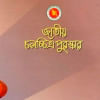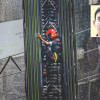Where is ‘Hangor Nodi Grenade’s Raees?

Acclaimed Bangladeshi author Selina Hossain's "Hangor Nodi Grenade" (Shark, River, Grenade) is a bold testament to the Liberation War 1971, representing not only the freedom fighters but how ordinary people of this country persevered, suffered and created resistance with no arms but life-altering sacrifices.
The story was supposed to be adapted to the screen by none other than maestro Satyajit Ray; however, it didn't happen. Later, acclaimed Bangladeshi director Chashi Nazrul Islam, a freedom fighter himself, adapted Selina's timeless classic tale into celluloid screen.

As the immensely impactful and popular film "Hangor Nodi Grenade" observes the 26th year of its release this year, journalist Makful Hossain from Prothom Alo traces back the footprints of one of its breakout stars, Bijoy Chowdhury, who portrayed the character of an autistic young man in the film and made this character a household name in Bangladesh since its release.
So much so that most people except his family and close friends call the actor Bijoy Chowdhury his character's name in the movie, Raees. Bijoy, a 51-year-old, is now a businessman and known by this name in his locality in Badda, Dhaka.

So what made the character of "Raees" so relatable to Bangladeshi audiences? "Chashi Sir offered me this film in 1994 when I was just a 22-year-old. The shooting for the film commenced only 25 days after that in Manikganj's Jhitka village with renowned actors Sohel Rana, Suchorita and Aruna Biswas in lead roles."
"We shot for 18 days straight. The film finally was released to the theatres on November 21, 1997. We had received so much love and appreciation for our movie from the masses, film industry legends and critics alike. It was phenomenal," said Bijoy.

"The most famous scene in the film, where 'Raees' gets shot by the Pakistani Army, I was feeling really nervous before that. But Chashi Nazrul Islam assured me and made me feel secure and finally, the shot was taken in only one shot," recalls Bijoy.
"After the film, people started calling me 'Raees' everywhere I went. Audiences loved me, and it is still the case 26 years after the release of the film. I really love it," said the actor.

Regarding the fame of Bijoy, his father, Monir Chowdhury, a retired official, said, "Even my friends call me by 'Raees's father'. I feel so proud of my son's achievements. He should have gotten the national award for his performance, but it is fine; he got the recognition he deserved from the masses. That makes me happy."
Bijoy Chowdhury debuted with Raihan Mujeeb's 1993 film "Prem Preeti", and his last film was "Lat Bhai" in 1997. Since he wasn't offered good characters like "Raees", he has not done any films since 1997, said Bijoy, adding that he will reconsider acting again if he gets good scripts.
After leaving the film industry, Bijoy ventured into the restaurant and textile export business as a professional career. Now, he has an office and Baridhara DOHS, where he exports textile garments to India. Bijoy, along with his family, often visits the village where the film was shot and receives the love he does in the film from the locals. "It is one of those instances where a character goes beyond itself and gets blended into reality, organically and soulfully," concludes Bijoy, adding about his character in the film and the heartwarming love that he receives for it.
Renowned filmmaker Chashi Nazrul Islam made the film in 1997, based on Selina Hossain's novel of the same name. Suchorita, Sohel Rana and Aruna Biswas are among the central cast. The film won three national film awards: Best Director (Chashi Nazrul), Best Story (Selina Hossain), and Best Actress (Suchorita).

 For all latest news, follow The Daily Star's Google News channel.
For all latest news, follow The Daily Star's Google News channel. 










Comments